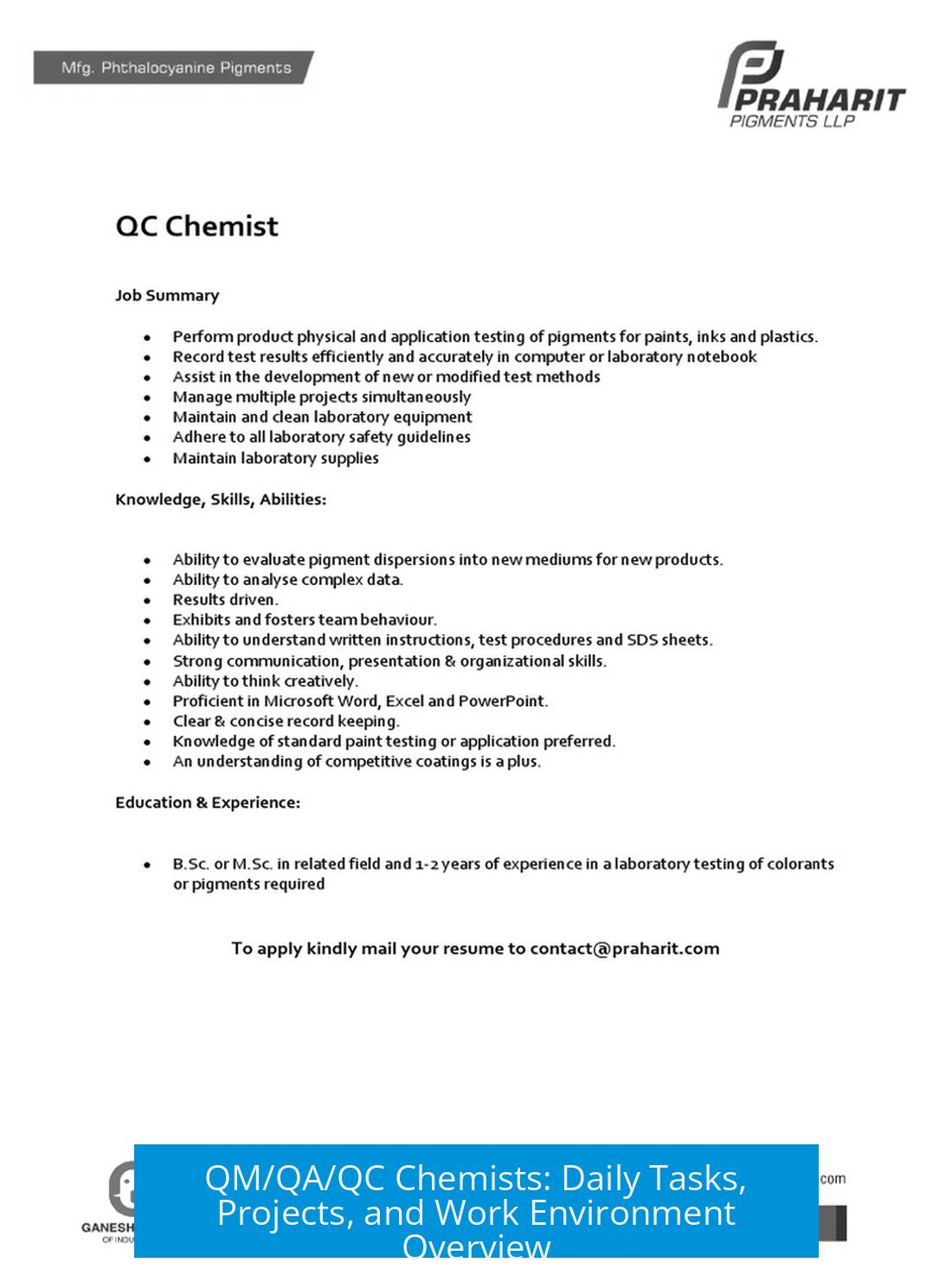QM/QA/QC Chemists: What Is Your Job Like?
QM/QA/QC chemists have a dynamic role involving both laboratory work and desk tasks, working daily to ensure product quality and process consistency through sampling, testing, data analysis, and reporting. Their workweek blends routine assays, instrument maintenance, and occasional project work shaped by the industry and company.
Understanding the QM/QA/QC Role
QM (Quality Management), QA (Quality Assurance), and QC (Quality Control) chemists have overlapping but distinctive duties.
- Quality Management (QM) focuses on the overall system ensuring quality standards are maintained.
- Quality Assurance (QA)
- Quality Control (QC)
These chemists work mostly in regulated industries such as pharmaceuticals, cosmetics, manufacturing, and energy.
Lab Work vs. Desk Work
QM/QA/QC chemists split their time between the laboratory and administrative tasks.
- Typical distribution is about 20 hours per week in the lab, with activities like titrations, sample processing, and instrument analysis.
- Desk work includes report writing, data review, and compliance documentation, which can take around 15 hours weekly.
- Time on plant floor or production support may add about 10 hours, depending on company size and needs.
Lab tasks involve both repetitive and complex assays. Simple measurements like pH and conductivity are routine. More detailed analysis like fatty acid and nitrogen content may require days.
Routine tests include:
- Calculating saponification values
- Titrations
- Sample preparation for HPLC (High-Performance Liquid Chromatography)
QM/QA/QC chemists also conduct routine recalibration and maintenance of analytical instruments to preserve accuracy.
Daily Task Breakdown
The daily schedule adjusts based on sample load and production status:
- Sample Collection: Gathering samples from production during running shifts.
- Sample Processing: Preparing samples for analysis, such as dilutions and extractions.
- Assay Execution: Running tests including titrations, chromatography, or spectroscopy.
- Data Analysis: Reviewing results and calculating key values.
- Reporting: Completing logs for state or federal regulatory compliance.
- Instrument Maintenance: Performing calibrations, troubleshooting instrument issues, especially with HPLC units.
- Administrative Communication: Responding to emails, coordinating with production, and documenting procedures.
When plants are idle, chemists often focus on lengthy analytical procedures or research.
Weekly Workflow and Projects
Weekly tasks combine routine duties with longer-term projects and professional development:
- Conduct regular assays for product batches according to the production schedule.
- Participate in process optimization efforts to improve efficiency or product quality, such as at biomass valorisation plants.
- Undertake literature reviews that provide scientific background for ongoing research projects. This typically requires 1-2 hours daily.
- Perform experiments occasionally (e.g., once a week) to test new methodologies or conduct system evaluations.
- Evaluate unique or unfamiliar samples, often in high-stakes environments requiring precise identification.
At times, higher management requests targeted short-term reports related to specific product streams or process issues.
Industries Employing QM/QA/QC Chemists
Chemists in these roles serve various sectors, each with specialized demands:
| Industry | Typical Role Focus | Analytical Techniques |
|---|---|---|
| Pharmaceuticals | In-process QC assays, batch release testing | HPLC, titrations, spectroscopy |
| Cosmetics | Raw material QA/QC, compliance with safety standards | pH measurement, viscosity, titrations |
| Biomass Valorisation | Process optimization, sample analysis | Chromatography, elemental analysis |
| Manufacturing and Metalworking | Waste treatment oversight, shipping compliance | Acid/base titrations, metal ion analysis |
Example Projects
- Magnetic phenomena studies in condensed matter at research labs.
- Gas adsorption research for renewable energy applications.
- Enhancing biomass plant process efficiency via chemical assay feedback.
Shift Patterns and Work Environment
Shift lengths vary with industry norms and production demand.
- 12-hour shifts are common in some sectors, especially production-linked QC roles.
- Smaller companies or research institutions often have more standard office hours.
- Some chemists appreciate the isolation when working solo, while others interact in team settings.
Career Path and Skills
Career progression in QM/QA/QC chemistry depends on education and experience.
- Entry often requires a bachelor’s degree in chemistry or a related field.
- Advanced roles, especially in research-intensive environments, usually demand a PhD.
- Technical skills include proficiency with HPLC, spectrometry, titration, data analysis, and regulatory knowledge.
- Soft skills like communication and organization improve career mobility.
Lab roles may lead to supervisory or managerial positions, often requiring transition toward desk work involving compliance and project management.
Summary
- QM/QA/QC chemists balance lab assays, data analysis, and documentation.
- They spend about 20 hours weekly performing lab work and 15 hours on administrative tasks.
- Work involves routine tests, instrument calibration, sampling, and compliance reporting.
- Projects vary from process optimization to scientific research depending on the sector.
- Shift patterns range from regular office hours to 12-hour shifts.
- Career development depends on education, with PhDs enabling research roles and advanced responsibilities.





Leave a Comment